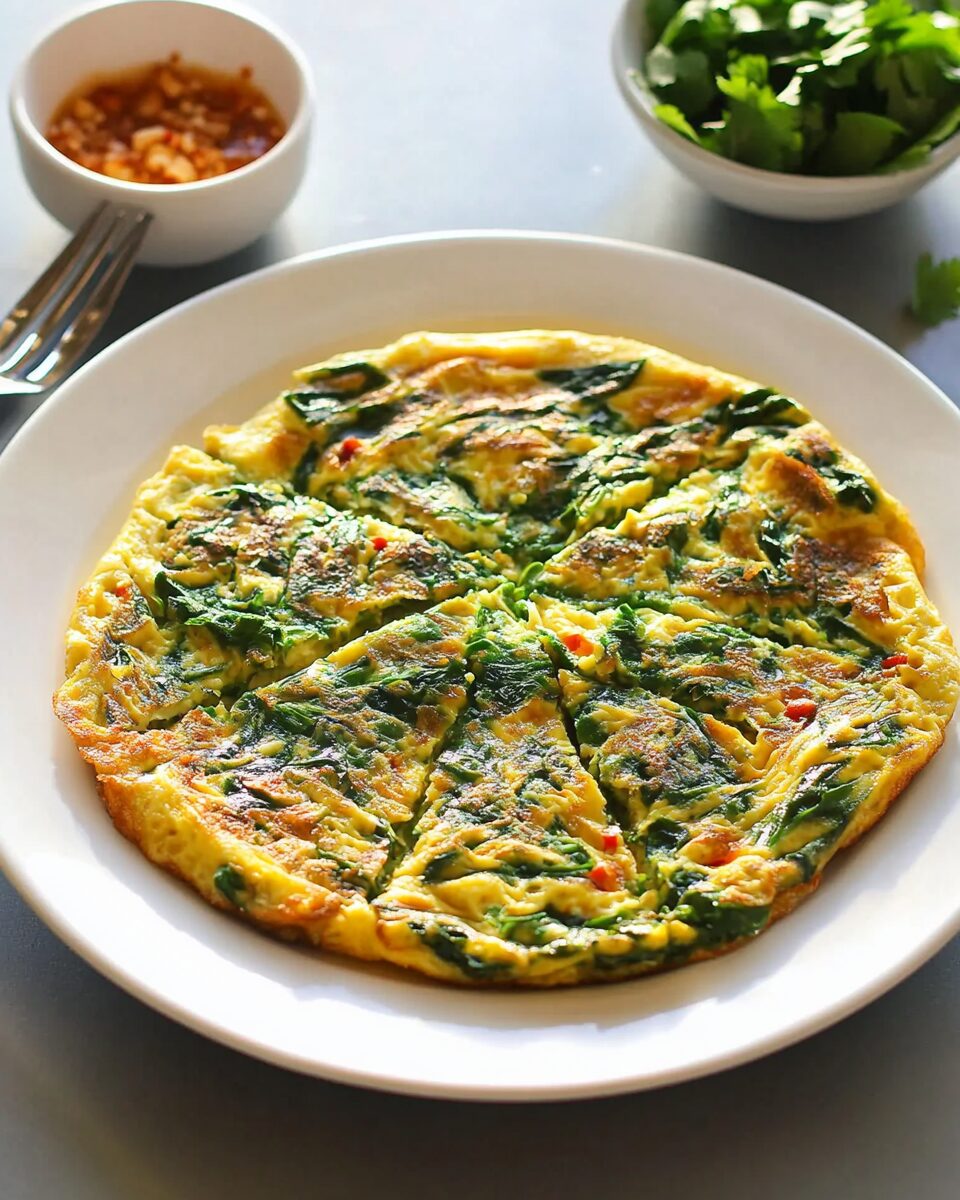What is Cha Om?
Cha om, or Acacia pennata, is a feathery, tender green found in many Southeast Asian dishes, especially in Thailand. Though it looks almost like a fern and has a slightly pungent, sulfurous aroma when raw, its flavor transforms when cooked—mellowing into a grassy, savory depth that pairs beautifully with eggs. It’s rich in vitamins A and C, iron, and antioxidants, making it not only flavorful but also nourishing.
Cha om is commonly used in omelettes (kai jeow cha om), curries, and even soups. It’s particularly beloved in rural Thai cuisine, where ingredients are often picked fresh from backyard gardens or local markets.
Cultural Significance of the Thai Omelette
The Thai-style omelette (kai jeow) is not your typical Western-style omelette. It’s usually thinner, crispier on the outside, and intensely savory. While it may be eaten for breakfast, it’s just as often served for lunch or dinner alongside steamed jasmine rice and a variety of other dishes.
In Thai cooking, an omelette isn’t just a quick meal—it’s a versatile side dish that complements a larger meal, balancing spicy soups, stir-fries, and salads. The addition of cha om elevates this everyday dish into something more unique and regionally significant, particularly in Central and Northern Thai cuisine.
Why This Recipe Works
This omelette is all about layering simple but powerful flavors. The eggs provide a creamy, neutral base, while garlic and chili add heat and depth. Fish sauce brings in umami and saltiness, sugar balances the sharp edges, and cha om contributes a slightly earthy, vegetal character.
Unlike Western-style omelettes that are often filled with cheese or vegetables and folded gently, the Thai version is more rustic and quick-fried, giving the edges a delightfully crisp texture. The high-heat frying method is essential to get that signature puffed, crispy surface while keeping the inside soft and flavorful.
Serving Suggestions
Traditionally, this omelette is served over a plate of steamed jasmine rice and paired with bold condiments. The most popular is Nam Prik Kapi—a pungent, spicy shrimp paste dip made with chilis, garlic, lime juice, and sometimes grilled eggplant. For a quicker option, diners often mix fish sauce with fresh chopped Thai chilis to make a simple but fiery dipping sauce.
The dish also complements:
-
Sautéed morning glory or bok choy
-
Thai-style soups like Tom Yum or Tom Kha
-
Sticky rice and grilled meats
-
Fresh cucumber slices to cool the palate
This makes it ideal not just for breakfast, but as a complete lunch or light dinner.
Nutritional Profile and Benefits
Though it looks like a comfort dish, the Thai omelette with cha om offers a decent nutritional punch. Eggs provide high-quality protein and healthy fats. Cha om is high in fiber and essential nutrients like calcium, vitamin C, and beta-carotene. Garlic and chili add immune-boosting and anti-inflammatory benefits. Together, the dish is low in carbs but rich in flavor, texture, and nutrients.
If you’re looking for a low-carb, gluten-free, and satisfying meal, this is a great choice. It’s filling without being heavy and keeps your palate excited with every bite.
Cooking Tips for the Perfect Thai Omelette
-
Use a well-seasoned wok or non-stick pan to prevent sticking and ensure easy flipping.
-
Heat the oil until very hot before adding the egg mixture—this gives the omelette its signature puff and crispy edges.
-
Don’t overcrowd with fillings. Cha om is enough to flavor the dish; overloading with other ingredients can weigh it down.
-
Use freshly chopped chili and garlic to maximize flavor intensity.
-
Fish sauce is key. It’s the backbone of Thai flavor, so try not to substitute it unless necessary. However, for vegetarian versions, soy sauce or mushroom sauce can be used.
Ingredient Substitutions and Variations
While the classic version is perfect as-is, here are a few ideas for adapting it to your preferences:
-
No cha om? Substitute with chopped scallions, spinach, or cilantro for a similar herbal effect.
-
Vegetarian version: Use soy sauce or mushroom sauce instead of fish sauce.
-
Make it more filling: Add minced shrimp, chicken, or tofu to the egg mixture.
-
Make it milder: Reduce or omit chili if you’re sensitive to spice.
-
Crispier version: Add a splash of soda water to the egg mixture for a fluffier omelette.
Why You’ll Love It
The Thai omelette with cha om offers an experience that’s quick to make, deeply satisfying, and uniquely flavorful. Its contrast of textures—crispy edges with a soft, tender middle—keeps every bite interesting. The herbaceous cha om gives it a flavor you won’t find in Western omelettes, while the fish sauce and chili deliver a burst of Thai authenticity.
Whether you’re craving something fast, need a side to a spicy curry, or want to explore traditional Thai home cooking, this dish checks every box. It’s minimal, flexible, and brimming with bold character.
Conclusion
Authentic Thai Omelette with Cha Om is proof that the most comforting dishes are often the simplest. With just a few ingredients and less than 10 minutes of cooking time, it transforms pantry staples into something remarkable. The unique flavor of cha om, the punch of garlic and chili, and the umami of fish sauce all come together in this golden, crispy-edged omelette.
It’s a dish that connects you directly to Thai culture—one bite and you’ll understand why this recipe has been a home-cooked favorite for generations. Add it to your rotation for an easy, nutritious, and flavorful escape to the vibrant kitchens of Thailand.






